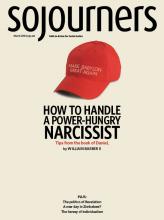ABOVE A 2002 article in The Irish News headlined “Priests present cheque to minister” is a photograph of a collared clergywoman surrounded by four Catholic priests. They stand shoulder to shoulder, all smiling, looking toward something ahead of them. Dominating the background is the burned-out shell of a church.
The backdrop of this image—destruction and religion—exemplifies Northern Ireland to much of the world. But the foreground, Catholic and Protestant clergy standing together, smiling toward an unknown future, might just represent what Northern Ireland—in spite of and because of its divisive and violent history—has to teach the U.S. and other countries who find themselves caught in a divisive and violent present.
During the predawn hours of Aug. 2, 2002, Whitehouse Presbyterian Church, on the north side of Belfast, went up in flames. The fire was first spotted by a Catholic taxi driver who lived across the street—he was up late that evening. He called the fire department, but there wasn’t much that could be done. By morning, as the bleary-eyed pastor and congregants of Whitehouse arrived, the building had burned to the ground.
Eventually, the fire was ruled arson—the third attempt in the year and a half that Rev. Liz Hughes had served as minister at Whitehouse, acts of destruction born of the ongoing conflict between Protestants and Catholics throughout Northern Ireland. By 2002, it had already been four years since the Good Friday accords were signed and peace was officially declared in the small, British-ruled country, but action had not entirely caught up to policy.
Read the Full Article

